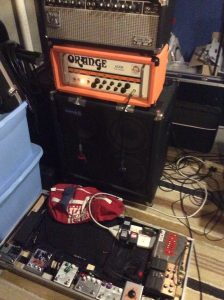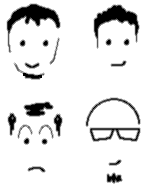2 November 2018, !THIS FRIDAY! – Dark Satellites at The All Star, Kansas City MO, with Ozersk, Americas (Chico, CA), and Reptoid (Oakland, CA). $??, ?? ages (all? check w/ venue), show at 7
Month: October 2018
-
Late-Breaking DS Show
-
Pedal Molarity
Poorly pictured below is my Sunn 4×10 cab, which I’ve re-wired for stereo in order to play both of my Mars Lights amps through it. (This way I don’t have to haul the Music Man’s cabinet to gigs. This may also work for h&s, Sneaky Sneaky Snakes, etc.; any situation where I’m using the GK pickup on my guitar.)

Not quite doing a full stack right… I want the cab’s speakers to all be in phase (all pushing or all pulling simultaneously, not one side pushing while the other side pulls). Sometimes pedals change the phase via latency, or flip its polarity* 180 degrees, so yesterday I tested all of my pedals to see what’s good to use when both amps are running through the Sunn cab. “Good,” in this case, means the pedal does not flip polarity in either bypassed or engaged mode.
* Polarity is whether, starting from silence, the first half-cycle of the sound wave is positive (pushes the speaker) or negative (pulls)
It felt a bit like making molar solutions in chemistry class; for whatever reason, the straightforward task doesn’t mesh with the normally-strong intuitive area of my brain, and completing it is a real challenge.
The whole process was a bit of overkill. There’s less of a phase relationship than I expected between the octave separation between the signals, the different distortion in each signal path, and the latency of the octave down signal. Still, the whole rig sounds slightly better (again, less than I expected but noticeable) when the polarity matches.
Results are that for most pedals, 80-85%, input and output polarity match and I can use them indiscriminately. (In retrospect, this is a good engineering practice generally.) I didn’t find any that change polarity in bypass mode. A handful change polarity when engaged; something like a one-transistor (MXR Micro Amp, Rangemasters, etc.) or three-transistor (Tone Bender family) is just going to do that in their normal configuration (each transistor gain stage flips the polarity of the signal) unless the engineer adds an amplifier stage to flip it back.
But because the rig as a whole needs one polarity flip to sound its best, I want to find an always-on polarity-flipping pedal for one of the signal paths. I have a couple candidates – my Falcon Heavy prototype’s second channel, a Basic Audio Scarab Deluxe fuzz – or I could build a simple high-headroom unity-gain single-JFET pedal for this specific use case. Probably would not have any controls or even a footswitch; just in and out jacks and power input. I plug it in, it does its thing.
I will probably do this. Maybe even today. Ack, I guess I need to prep a box first. Maybe I’ll do *that* today.
tl;dr – Bunch of pedal-geeky stuff, now I don’t have to haul a 2nd cab to Mars Lights and other gigs where I’m using my octave-down guitar thing, spent a few hours working on stuff only recording engineers will notice.
-
Bigger Sounds’ 4-Track
In the course of writing a yet-to-be-published post about sonic connections between V For Voice songs and older stuff, I got stuck listening to most of Bigger Sounds From Fewer Folks a weekend or two ago.

My memories of hunkering under my bunk in Frees Hall, recording those first songs to 4-track, are pretty clear. (For my own parts, anyway; I have no memory of recording Scott’s!) But it struck me; I didn’t own a 4-track at the time, so it must have been borrowed. Cory helped me narrow the suspects down to Josh O, Wisecarver, and Lupo.
Pretty sure it wasn’t Lupo’s; that just doesn’t ring any bells at all. I feel like it was Josh’s, but a passionate advocate could probably convince me it was Matt’s.
It doesn’t matter at all, it’s just a bit weird to think back to how for the first couple years I was working with borrowed gear (the 4-track for Bigger…, then Fred Ritter’s digital 8-track for Near and Far, etc.). I could have afforded a system like either of those, and I wonder why it took two records plus a doing bunch of other less-official recording to go ahead and buy something.
No real point here; idle observation only.
-
You Will Be Surprised…
… with some of the sounds we used a bunch on the h&s record. I’ve noticed this week as I’ve been able to step back and listen to the whole thing, not focusing on crossing off the last to-do items for each individual song.
Some of these are:
- Bass fuzz! I don’t mean a little color or grind; I mean full-on fuzz to take song sections over the top
- Hammond. Unfortunately this had to be done with a plugin – for all our gear, we don’t have a six-thousand-dollar organ and rotary speaker cabinet lying around – but it’s a very good-sounding one and it shows up in a lot of tunes
- Winds (beyond sax and flute); trumpet, clarinet, and bass clarinet add a lot to one song in particular. Hearing what Scottie did with the clarinets whet my appetite for more of that
- Guitar feedback, for transitions, live-in-the-studio leave-it-in vibes, and in one case as a massive, many-voiced choir of soft-ish feedback
- Analog synthesizer including Korg MS-20, Akai AX-60, and Korg Volca Bass. The polyphonic AX-60 was the workhorse here, for pads and arpeggios; the others make special guest appearances
- Guitar modulation effects; phaser, flanger, and filter (with modulated cutoff frequency). Sometimes these are used conventionally, sometimes… not
All in all we’re probably just short of pocket symphony / “lush” territory, but squarely in full-band, kitchen-sink mode. In other words, remember the end of “Blues or Astroblue?”
Almost every song gets there :)
